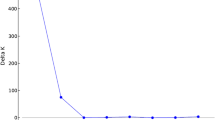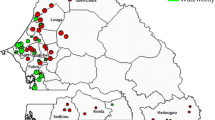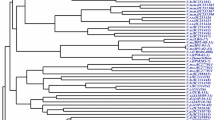Abstract
Genetic diversity and population genetic structure of natural Oryza rufipogon populations in China were studied based on ten microsatellite loci. For a total of 237 individuals of 12 populations collected from four regions, a moderate to high level of genetic diversity was observed at population levels with the number of alleles per locus (A) ranging from 2 to 18 (average 10.6), and polymorphic loci (P) from 40.0% to 100% (average 83.3%). The observed heterozygosity (H O ) varied from 0.163 to 0.550 with the mean of 0.332, and the expected heterozygosity (H E ) from 0.164 to 0.648 with the mean of 0.413. The level of genetic diversity for Guangxi was the highest. These results are in good agreement with previous allozyme and RAPD studies. However, it was unexpected that high genetic differentiation among populations was found (R ST = 0.5199, θ = 0.491), suggesting that about one-half of the genetic variation existed between the populations. Differentiation (pairwise θ) was positively correlated with geographical distance (r = 0.464), as expected under the isolation by distance model. The habitat destruction and degradation throughout the geographic range of O. rufipogon may be the main factor attributed to high genetic differentiation among populations of O. rufipogon in China.


Similar content being viewed by others
References
Akiga H, Yokozeki Y, Inagaki A, Fujimura T (1996) Microsatellite DNA markers for rice chromosomes. Theor Appl Genet 93:1071–1077
Barbier P (1989) Genetic variation and ecotypic differentiation in the wild rice Oryza rufipogon. II. Influence of the mating system and life-history traits on the genetic structure of populations. Jpn J Genet 64:273–285
Chang TT (1984) Conservation of rice genetic resources: luxury or necessity. Science 224:251–256
Chen X, Temnykh S, Xu Y, Cho YG, McCouch SR (1997) Development of a microsatellite framework map providing genome-wide coverage in rice (Oryza sativa L.) Theor Appl Genet 95:553–567
Cho YG, Ishii T, Temnhkh S, Chen X, Lipovich L, McCouch SR, Park WD, Ayres N, Cartinhour S (2000) Diversity of microsatellites derived from genomic libraries and GenBank sequences in rice (Oryza sativa L.). Theor Appl Genet 100:713–722
Collevatti RG, Grattapaglia D, Hay JD (2001) Population genetic structure of the endangered tropical tree species Caryocar brasiliense, based on variability at microsatellite loci. Mol Ecol 10:349–356
Davierwala AP, Chowdari KV, Kumar S, Peddy APK, Ranjekar PK, Gupta VS (2000) Use of three different marker systems to estimate genetic diversity of Indian elite rice varieties. Genetica 108:269–284
Freville H, Justy F, Olivieri I (2001) Comparative allozyme and microsatellite population structure in a narrow endemic plant species, Centaurea corymbosa Pourret (Asteraceae). Mol Ecol 10:879–889
Gao LZ, Ge S, Hong DY (2000) Allozyme variation and population genetic structure of common wild rice Oryza rufipogon Griff. in China. Theor Appl Genet 101:494–502
Garland SH, Lewin L, Abedinia M, Henry R, Blakeney A (1999) The use of microsatellite polymorphisms for the identification of Australian breeding lines of rice (Oryza sativa L.). Euphytica 108:53–63
Ge S, Oliveira GCX, Schaal BA, Gao LZ, Hong DY (1999) RAPD variation within and between natural populations of the wild rice Oryza rufipogon from China and Brazil. Heredity 82:638–644
Goodman SJ (1997) R ST Calc: a collection of computer programs for calculating estimates of genetic differentiation from microsatellite data and determining their significance. Mol Ecol 6:881–885
Goudet J (2001) FSTAT, a program to estimate and test gene diversities and fixation indices (Version 2.9.3). From http://www.unil.ch/izea/softwares/fstat.html
Goudet J, Raymond M, Meeus TD, Rousset F (1996) Testing differentiation in diploid populations. Genetics 144:1933–1940
Guadagnuolo R, Bianchi DS, Felber F (2001) Specific genetic markers for wheat, spelt and four wild relatives: comparison of isozymes, RAPDs and wheat microsatellites. Genome 44:610–621
Hamrick JL, Godt MJW (1989) Allozyme diversity in plant species. In: Brown AHD, Clegg MT, Kahler AL, Weir BS (eds) Plant population genetics, breeding, and genetic resources. Sinauer Associates, Sunderland, pp 43–63
Ishii T, Xu Y, McCouch SR (2001) Nuclear- and chloroplast-microsatellite variation in A-genome species of rice. Genome 44:658–666
Khush GS (1997) Origin, dispersal, cultivation and variation of rice. Plant Mol Biol 35:25–34
Lemaire C, Allegrucci G, Naciri M, Bahri-Sfar L, Kara H, Bonhomme F (2000) Do discrepancies between microsatellite and allozyme variation reveal differential selection between sea and lagoon in the sea bass (Dicentrarchus labrax)? Mol Ecol 9:457–467
McCouch SR, Chen X, Panaud O, Temnhkh S, Xu Y, Cho YG, Huang N, Ishii T, Blair M (1997) Microsatellite marker development, mapping and application in rice genetics and breeding. Plant Mol Biol 35:89–99
Morishima H, Barbier P (1990) Mating system and genetic structure of natural populations in wild rice, Oryza rufipogon. Plant Species Biol 5:31–39
Nei M (1978) Estimation of average heterozygosity and genetic distance from a small number of individuals. Genetics 89:583–590
Ohta T (1982) Linkage disequilibrium due to random drift in finite subdivided populations. Proc Natl Acad Sci USA 79:1940–1944
Oka HI (1988) Origin of cultivated rice. Japan Scientific Societies Press, Tokyo
Olsen KM, Schaal BA (2001) Microsatellite variation in cassava (Manihot esculenta, Euphorbiaceae) and its wild relatives: further evidence for a southern Amazonian origin of domestication. Am J Bot 88:131–142
Olufowote JO, Xu Y, Chen X, Park WD, Beachel HM, Dilay RH, Goto M, McCouch SR (1997) Comparative evaluation of within-cultivar variation of rice (Oryza sativa L.) using microsatellite and RFLP markers. Genome 40:370–378
Page RDM (1996) TreeView: an application to display phylogenetic trees on personal computers. Comput Appl Biosci 12:357–358
Panaud O, Chen X, McCouch SR (1996) Development of microsatellite markers and characterization of simple sequence length polymorphism (SSLP) in rice (Oryza sativa L.). Mol Gen Genet 252:597–607
Pemberton JM, Slate J, Bancroft DR, Barrett JA (1995) Non-amplyfying alleles at microsatellite loci: a caution for parentage and population studies. Mol Ecol 4:249–252
Powell W, Machray GC, Provan J (1996) Polymorphism revealed by simple sequence repeats. Trends Plant Sci 1:215–222
Provan J, Corbett G, McNicol JW, Powell W (1997) Chloroplast DNA variability in wild and cultivated rice (Oryza sativa) revealed by polymorphic chloroplast simple sequence repeats. Genome 40:104–110
Rice WR (1989) Analyzing tables of statistics tests. Evolution 43:223–225
Roa AC, Chavarriaga-Aguirre P, Duque MC, Maya MM, Bonierbale MW, Iglesias C, Tohme J (2000) Cross-species amplication of Cassava (Manihot esculenta) (Euphorbiaceae) microsatellites: allelic polymorphism and degree of relationship. Am J Bot 87:1647–1655
Slaktin M (1995) A measure of population subdivision based on microsatellite allele frequencies. Genetics 139:457–462
Smulders MJM, Bredemeijer G, Rus-Kortekass W, Arens P, Vosman B (1997) Use of short microsatellites from database sequences to generate polymorphisms among Lycopersicon esculentum cultivars and accessions of other Lycopersicon species. Theor Appl Genet 97:264–272
Streiff R, Labbe T, Bacilieri R, Steinkellner H, Glossl J, Kremer A (1998) Within-population genetic structure in Quercus robur L. and Quercus petraea (Matt.) Liebl. assessed with isozymes and microsatellites. Mol Ecol 7:317–328
Sun CQ, Wang XK, Li ZC, Yoshimura A, Iwata N (2001) Comparison of the genetic diversity of common wild rice (Oryza rufipogon Griff.) and cultivated rice (O. sativa L.) using RFLP markers. Theor Appl Genet 102:157–162
Sun GL, Diaz O, Salomon B, von Bothmer R (1999) Genetic diversity in Elymus caninus as revealed by isozyme, RAPD and microsatellite markers. Genome 42:420–431
Temnykh S, Park WD, Ayres N, Cartinhour S, Hauck N, Lipovich L, Cho YG, Ishii T, McCouch SR (2000) Mapping and genome organization of microsatellite sequences in rice (Oryza sativa L.). Theor Appl Genet 100:697–712
Vaughan DA (1994) The wild relatives of rice: a genetic resources handbook. International Rice Research Institute, Manila, The Philippines
Weir BS, Cockerham CC (1984) Estimating F-statistics for the analysis of population structure. Evolution 38:1358–1370
Wright S (1978) Evolution and the genetics of populations, vol. 4. Variability within and among natural populations. University of Chicago Press, Chicago
Wu KS, Tanksley SD (1993) Abundance, polymorphism and genetic mapping of microsatellites in rice. Mol Gen Genet 241:225–235
Xiao J, Grandillo S, Ahn SN, McCouch SR, Tanksley SD (1996) Genes from wild rice improve yield. Nature 384:223–224
Xie ZW (1999) Population genetics and conservation strategies of Oryza rufipogon Griff. in China. PhD dissertation, Institute of Botany, Chinese Academy of Sciences, Beijing, China
Xie ZW, Lu YQ, Ge S, Hong DY, Li FZ (2001) Clonality in wild rice (oryza rufipogon, Poaceae) and its implications for conservation management. Am J Bot 88:1058–1064
Yang GP, Saghai Maroof MA, Xu CG, Zhang QF, Biyashev RM (1994) Comparative analysis of microsatellite DNA polymorphism in landraces and cultivars rice. Theor Appl Genet 245:187–194
Yeh FC, Yang RC, Boyle T (1999) POPGENE version1.32, Microsoft window-base software for population genetic analysis: a quick user's guide. University of Alberta, Center for International Forestry Research, Alberta, Canada
Zhao XP, Kochert G (1992) Characterization and genetic mapping of a short, highly repeated, interspersed DNA sequence from rice (Oryza sativa L.). Theor Appl Genet 231:353–359
Acknowledgements
We thank Dr. Li-zhi Gao, the Institute of Crop Germplasm Resources of the Chinese Academy of Agricultural Sciences, for his technological assistance and providing microsatellite primers. We are also grateful to Dr. Wei Qian for his assistance in the field collections. This research was supported by the National Natural Science Foundation of China (30025005) and the Chinese Academy of Sciences (kscxz-sw-101A).
Author information
Authors and Affiliations
Corresponding author
Additional information
Communicated by H.F. Linskens
Rights and permissions
About this article
Cite this article
Zhou, Hf., Xie, Zw. & Ge, S. Microsatellite analysis of genetic diversity and population genetic structure of a wild rice (Oryza rufipogon Griff.) in China. Theor Appl Genet 107, 332–339 (2003). https://doi.org/10.1007/s00122-003-1251-y
Received:
Accepted:
Published:
Issue Date:
DOI: https://doi.org/10.1007/s00122-003-1251-y




